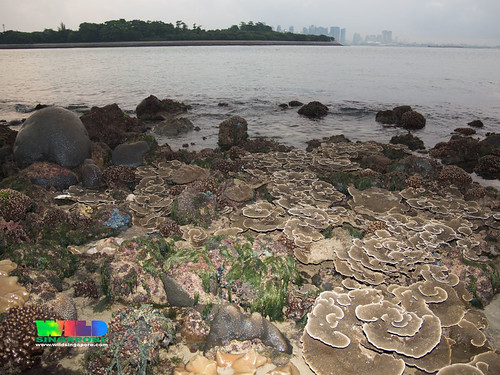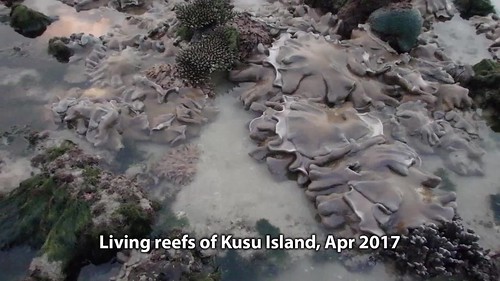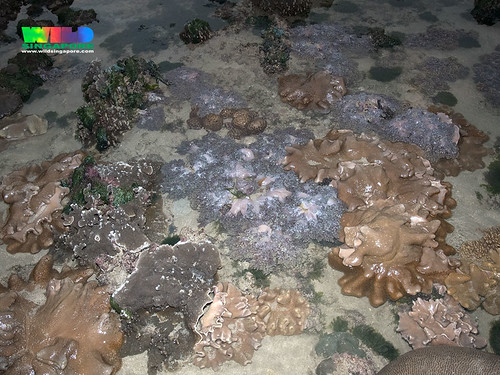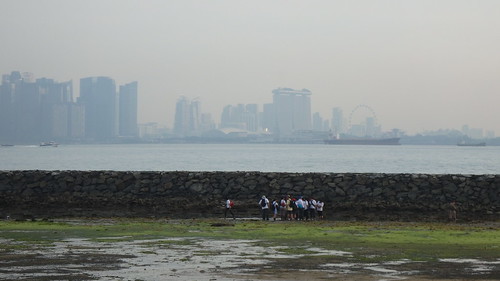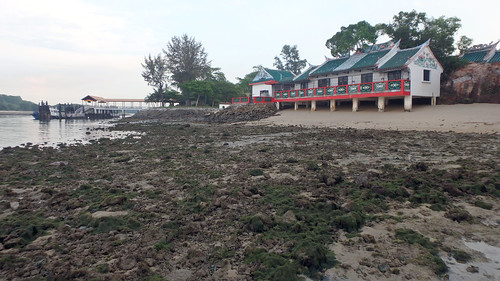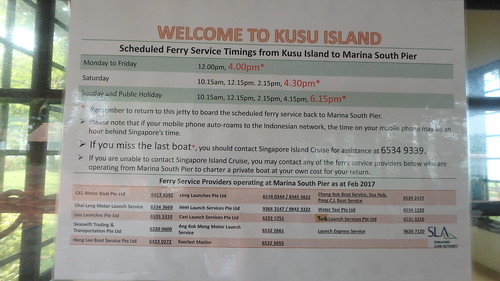This is what this part of Kusu looked like on our last survey in July 2016 at the height of mass coral bleaching. At that time, we estimated about 50% of the hard corals and 50% of the leathery soft corals were bleaching. And also noticed about 5-10% of corals have died recently.
Today, even the patch of plate corals are still alright!
Here's a video of the reefs and some of the animals I saw today.
Pei Yan flew the drone today! And it looks like there is no more mass coral bleaching at Kusu Island.
It was good to see some of the Branching montipora corals in the lagoon were recovering. Although the patch is not as dense as it used to be. On the seaward side, there were many Acropora coral colonies that looked healthy. There were also some small Cauliflower coral colonies.
Many animals live among corals. Today, we saw many small Arabian cowries. And I saw some animals that can only live in corals. This includes a glimpse of the Acropora goby, and several Red coral crabs.
Plate forming corals were still abundant on the seaward side of the reef. Although I didn't see many Disk corals.
In the lagoon, many of the boulder-shaped corals look really beat up with mostly dead portions and only small parts still alive. Yet, there were many small colonies that appear to be growing on these larger colonies.
There were lots of healthy looking large leathery soft corals and large Asparagus flowery soft corals.Plate forming corals were still abundant on the seaward side of the reef. Although I didn't see many Disk corals.
In the lagoon, many of the boulder-shaped corals look really beat up with mostly dead portions and only small parts still alive. Yet, there were many small colonies that appear to be growing on these larger colonies.
I saw a few Haddon's carpet anemones in the lagoon and they were not bleaching. I saw a few Frilly anemones on the rocky shore near the jetty. On the reef facing the city, there were a lot a lot of Magnificent anemones, many appear small. And many Giant carpet anemones too. They were all not bleaching.
Anemones are homes to animals such as Clown anemonefish and Anemone shrimps. We saw these in some of the anemones.
The larger lagoon facing the city is dotted with tiny Spoon seagrass and skinny and short Needle seagrass. The other lagoon had fresh green patches of Needle Seagrass. And near the jetty, the little patch of Tape seagrass has grown! I saw a female flower. There was a bloom of Sea lettuce in the large lagoon, and near the jetty a bloom of Hairy green seaweed.
Chay Hoon found a special snail we have never seen before!
There were lots of Common sea stars in the smaller lagoon and they were almost all in 'mating position', The rest of the team also saw many small heart urchins on the surface (these are usually buried). Perhaps they came up to mate too?
It was a very dark new moon. Great for mating! Here we are starting our survey before dawn in the light of the Central Business District just minutes away from the reef.
Just before sunrise, I heard the calls of two Spotted wood owls! I searched for them after day break but couldn't find them. I did come across some bat skulls that may have been barfed up by the owls. So exciting!
At sunrise, an intertidal tour by the Lee Kong Chian Natural History arrived to have a look at the marine life here.
Kusu Island is also full of history, with a famous temple, and shrine at the top of a little hill. Here's more about the legends and history of Kusu Island.
Kusu Island is now managed by SLA (previously it was managed by Sentosa Development Corporation). On the way home in the boat, we saw patches of tiny black dots of oil. Oh dear.
Let's hope this beautiful little island remains well until we visit it again.
Posts by others on this trip
- Chay Hoon on facebook.
- Heng Pei Yan on facebook and her blog.
- Ian Siah on facebook.
- Richard Kuah on facebook and his blog.
- Loh Kok Sheng on facebook and his blog.
- Marcus Ng and Nicole Wong on facebook.
- Choo Yi Feng on facebook.



